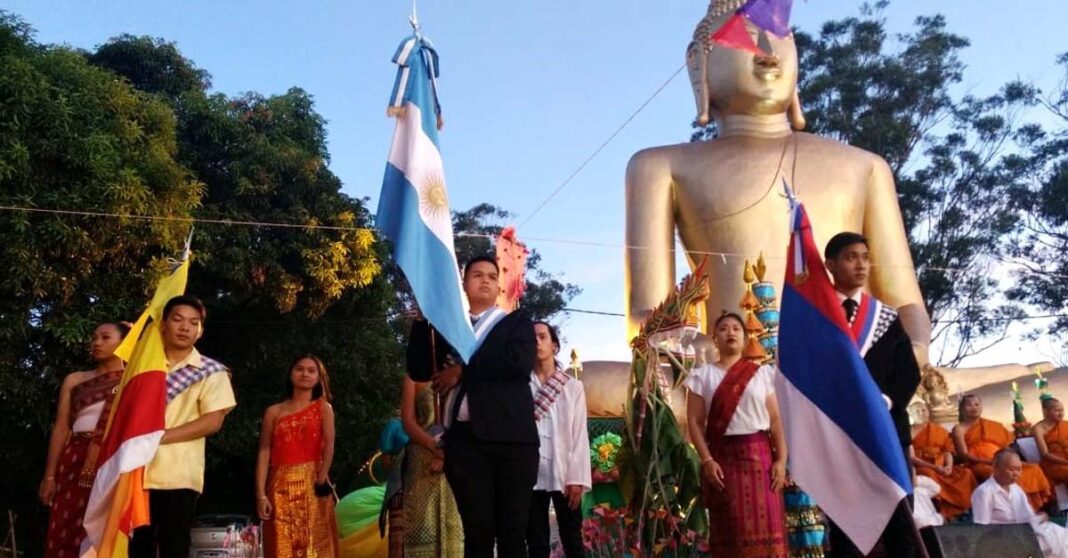Hundreds of thousands of Laotian refugees who escaped the Secret War settled in major Western countries such as the US, France, and Canada, through a resettlement program to ensure their safety and survival. However, it is not widely known that many more countries took part in these resettlement programs. Today, we will take a look at one such community, where a substantial number of Laotians have made their home in the far northeast region of Posadas, Argentina.
Mr. Pong Bounchanavong attended the video call interview wearing a sleeveless Beerlao shirt that he bought when visiting Laos years ago; although Beerlao is extremely rare in Argentina (or perhaps because it is so rare), he proudly displays the iconic Lao national beer insignia often in his day-to-day life. He introduced his wife Ms. Somboun Hamsouvan who has been in Argentina for nearly 50 years and runs a garment business and shop in the city of Posadas.
“We moved here in 1975 after fleeing from the war into a UN resettlement program for Lao people. My father selected Argentina although he did not know the place and did not have many choices, but needed to get out of the resettlement camp as soon as possible due to the crowding and difficulties,” Mr. Pong Bounchanavong says, before hurrying out of the frame momentarily to greet customers in his shop with a flurry of fluent Spanish.
Unfortunately, upon arrival in Argentina, Laotian refugees were separated from each other, with some families living far apart in rural areas of the country and not quite maintaining contact with their relatives who had also migrated to the same country. This caused fragmentation and disintegration within the community, and many families had to go undertake great efforts to keep their language and culture alive so far from home.
“My family was assigned to a room with walls that separated us from others and we awaited legal documents to reside there for a month. My parents were taught Spanish, but due to the constraints of time and relocation, they were unable to communicate in the language fully. Some families were sent to work on the border near Bolivia, picking oranges, limes, and pomelos,” Ms. Somboun says, struggling to pronounce the names of the fruits in Lao. Her speech is peppered with sudden interjections of Spanish–a testament to the difficulties of keeping Lao language fluency so far from home, especially before the era of internet media brought the world closer.

Many younger Laotian-Argentinians also find it difficult to uphold their linguistic heritage and cultural awareness, given that Spanish is so prevalent within the Lao population in Argentina, and adapting to traditional practices can also pose difficulties for some.
“Some of the young Lao people in Argentina feel unfamiliar when they wear traditional Lao outfits… Women don’t want to wear the Sinh anymore because they feel uncomfortable walking in it,” says Ms. Somboun.
Culturally, the Lao community desired a way to maintain customs and traditions and the way of Buddhism that they had left as they relocated to a new country.
“In the past the Lao community used to try to practice Christianity like Argentinians, however, some of the older generations wished to preserve their Lao identity and Buddhist practices in their daily lives. Some spoke of wanting to die in a Lao Buddhist way,” says the President of Templo Budista Laos, Ms. Crystal Bounxayavong.
Laotian immigrants in Argentina built the first and only Lao Buddhist temple in the late 1970s in Posadas, Misiones Province, where Laotians could socialize and reconnect with their missing relations, re-building connections between the culture and the people where gatherings and religious ceremonies are often organized.
“I feel very blessed to have managed to bring the monks from Laos to Argentina to help reconnect us with our traditions,” she says.
Most Lao-Argentinians chose to settle and live in the north of Argentina, near Posadas, where the climate is similar to that of their home country, even though the two counties are quite distant geographically.
“Lao people cultivate bamboo and papaya as the hot and humid weather conditions are perfect for their cultivation. Also, some products here, like rice, are very inexpensive,” say Mr. Pong and his wife.
The Laotian community in Argentina combines their traditional cuisine with local Argentinian dishes, taking advantage of the country’s reputation for producing high-quality meat. Argentinian cuisine, characterized by its well-prepared cuts of pork and beef, goes hand in hand with the delectable flavors of Laotian cuisine.
“It’s a must for Lao people here to have papaya salad and bamboo soup with some Argentinian grilled beef or ribs. When we share our food with the Argentinians at the temple, they like to knead the rice into a ball shape like Lao people,” he says.
With the soaring rate of inflation plaguing Argentina currently, many Laotians struggle to make a living, but their inherent skills, heritage, and traditional ways of living in harmony with nature provide relief.
“The inflation in Argentina is quite challenging as it increases every week, but fortunately, the government assists children and the elderly during such tough times. The cost of living in Argentina is high, but it is still livable for now,” says Mr. Pong’s wife.
Despite a separation from their homeland and the hardships of restarting life in a new foreign country several decades ago, this group of Laotian-Argentinians highlighted their commitment to preserve their cultural identities so that they would be recognized as Laotians no matter where they are.
“We don’t want to travel anywhere other than our own home country. We get emotional when we see Lao traditions being celebrated on social media, but now, since we reside in Argentina, we try and keep our culture alive here as much as we can.” the Laotian-Argentine couple says.



